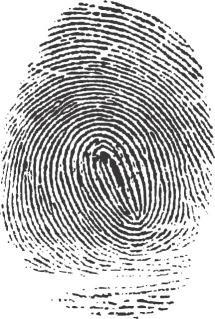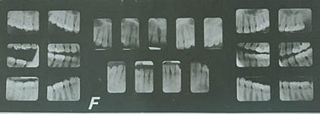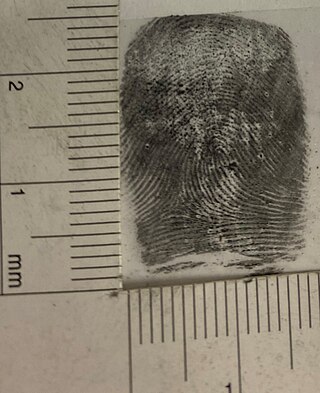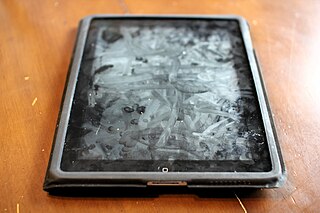Related Research Articles

Forensic science, also known as criminalistics, is the application of science principles and methods to support legal decision-making in matters of criminal and civil law.

A fingerprint is an impression left by the friction ridges of a human finger. The recovery of partial fingerprints from a crime scene is an important method of forensic science. Moisture and grease on a finger result in fingerprints on surfaces such as glass or metal. Deliberate impressions of entire fingerprints can be obtained by ink or other substances transferred from the peaks of friction ridges on the skin to a smooth surface such as paper. Fingerprint records normally contain impressions from the pad on the last joint of fingers and thumbs, though fingerprint cards also typically record portions of lower joint areas of the fingers.
Biometrics are body measurements and calculations related to human characteristics. Biometric authentication is used in computer science as a form of identification and access control. It is also used to identify individuals in groups that are under surveillance.

Anthropometry refers to the measurement of the human individual. An early tool of physical anthropology, it has been used for identification, for the purposes of understanding human physical variation, in paleoanthropology and in various attempts to correlate physical with racial and psychological traits. Anthropometry involves the systematic measurement of the physical properties of the human body, primarily dimensional descriptors of body size and shape. Since commonly used methods and approaches in analysing living standards were not helpful enough, the anthropometric history became very useful for historians in answering questions that interested them.

Forensic dentistry or forensic odontology involves the handling, examination, and evaluation of dental evidence in a criminal justice context. Forensic dentistry is used in both criminal and civil law. Forensic dentists assist investigative agencies in identifying human remains, particularly in cases when identifying information is otherwise scarce or nonexistent—for instance, identifying burn victims by consulting the victim's dental records. Forensic dentists may also be asked to assist in determining the age, race, occupation, previous dental history, and socioeconomic status of unidentified human beings.
The Henry Classification System is a long-standing method by which fingerprints are sorted by physiological characteristics for one-to-many searching. Developed by Hem Chandra Bose, Qazi Azizul Haque and Sir Edward Henry in the late 19th century for criminal investigations in British India, it was the basis of modern-day AFIS classification methods up until the 1990s. In recent years, the Henry Classification System has generally been replaced by ridge flow classification approaches.
Forensic identification is the application of forensic science, or "forensics", and technology to identify specific objects from the trace evidence they leave, often at a crime scene or the scene of an accident. Forensic means "for the courts".

Fingerprint powders are fine powders used, in conjunction with fingerprint brushes, by crime scene investigators and other law enforcement personnel to search for and enhance latent/invisible fingerprints that can be used to determine identification. This method of fingerprint development commonly referred to as dusting for fingerprints, involves the adherence of the powder particles to the moisture and sweat secretions deposited on to surfaces by the raised ridges on fingers, palms, or soles of feet designed for grip, called friction ridges.

Forensic biology is the use of biological principles and techniques in the context of law enforcement investigations.

Dermatoglyphics is the scientific study of fingerprints, lines, mounts and shapes of hands, as distinct from the superficially similar pseudoscience of palmistry.

Footprints are the impressions or images left behind by a person walking or running. Hoofprints and pawprints are those left by animals with hooves or paws rather than feet, while "shoeprints" is the specific term for prints made by shoes. They may either be indentations in the ground or something placed onto the surface that was stuck to the bottom of the foot. A "trackway" is a set of footprints in soft earth left by a life-form; animal tracks are the footprints, hoofprints, or pawprints of an animal.
A device fingerprint or machine fingerprint is information collected about the software and hardware of a remote computing device for the purpose of identification. The information is usually assimilated into a brief identifier using a fingerprinting algorithm. A browser fingerprint is information collected specifically by interaction with the web browser of the device.

Body identification is a subfield of forensic science that uses a variety of scientific and non-scientific methods to identify a body. Forensic purposes are served by rigorous scientific forensic identification techniques, but these are generally preceded by formal identification. This involves requesting a family member or friend of the victim to visually identify the body.
In bio-informatics, a peptide-mass fingerprint or peptide-mass map is a mass spectrum of a mixture of peptides that comes from a digested protein being analyzed. The mass spectrum serves as a fingerprint in the sense that it is a pattern that can serve to identify the protein. The method for forming a peptide-mass fingerprint, developed in 1993, consists of isolating a protein, breaking it down into individual peptides, and determining the masses of the peptides through some form of mass spectrometry. Once formed, a peptide-mass fingerprint can be used to search in databases for related protein or even genomic sequences, making it a powerful tool for annotation of protein-coding genes.

Glove prints, also sometimes described as gloveprints or glove marks, are latent, fingerprint-like impressions that are transferred to a surface or object by an individual who is wearing gloves.

A smudge attack is an information extraction attack that discerns the password input of a touchscreen device such as a cell phone or tablet computer from fingerprint smudges. A team of researchers at the University of Pennsylvania were the first to investigate this type of attack in 2010. An attack occurs when an unauthorized user is in possession or is nearby the device of interest. The attacker relies on detecting the oily smudges produced and left behind by the user's fingers to find the pattern or code needed to access the device and its contents. Simple cameras, lights, fingerprint powder, and image processing software can be used to capture the fingerprint deposits created when the user unlocks their device. Under proper lighting and camera settings, the finger smudges can be easily detected, and the heaviest smudges can be used to infer the most frequent input swipes or taps from the user.
Biometrics refers to the automated recognition of individuals based on their biological and behavioral characteristics, not to be confused with statistical biometrics; which is used to analyse data in the biological sciences. Biometrics for the purposes of identification may involve DNA matching, facial recognition, fingerprints, retina and iris scanning, voice analysis, handwriting, gait, and even body odor.

A biometric device is a security identification and authentication device. Such devices use automated methods of verifying or recognising the identity of a living person based on a physiological or behavioral characteristic. These characteristics include fingerprints, facial images, iris and voice recognition.

Forensic firearm examination is the forensic process of examining the characteristics of firearms or bullets left behind at a crime scene. Specialists in this field try to link bullets to weapons and weapons to individuals. They can raise and record obliterated serial numbers in an attempt to find the registered owner of a weapon and look for fingerprints on a weapon and cartridges.

Neurotechnology is an algorithm and software development company founded in Vilnius, Lithuania in 1990.
References
- ↑ "Kuhn, Kurt E. (1994). "The Fingerprint Science and Ridgeology"" (PDF). Archived from the original (PDF) on 2019-06-08. Retrieved 2019-06-08.